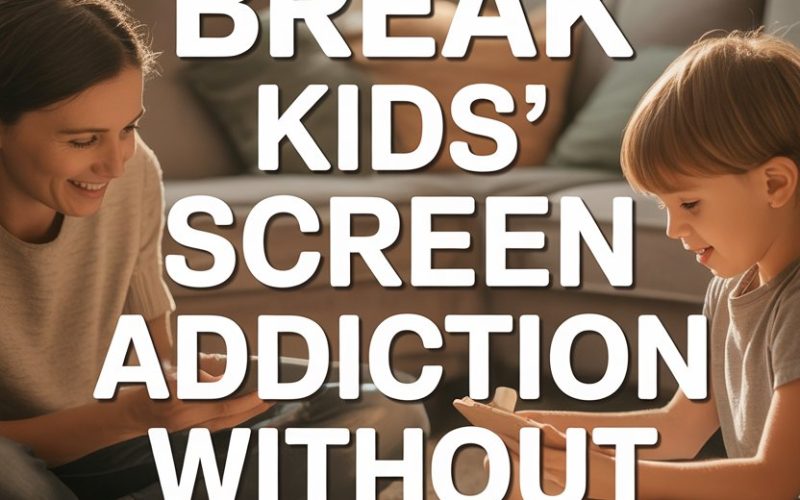If your child’s hands seem permanently fused to a tablet, you’re not alone.
Screens are everywhere, and prying kids away without a meltdown can feel like trying to separate a toddler from their favourite snack (read: not recommended for the faint-hearted).
The good news? There are gentler ways to break the spell—without turning your home into a battleground.
Spotting Screen Overload Before It Turns Nuclear
Before donning your digital referee kit, it’s worth knowing what too much screen time can look like. I
rritability, tantrums at device removal, sleep issues, and a sudden inability to function at family dinner (unless there’s a YouTube video handy) are common red flags.
The American Academy of Pediatrics suggests sensible limits, especially for kids under six. Still, many parents realise things have gone a bit sideways only once Netflix is the only babysitter that never takes a break.
Why Kids Get Hooked—And Why It’s Not Just Laziness
Screen-based activities light up the pleasure centres in children’s brains, much like sugar or winning at Mario Kart. Games and videos are designed to keep kids engaged, and apps are experts at dangling “just one more” in front of little eyes.
Kids aren’t weak; they’re outmatched by an industry packed with PhDs in engagement. Treating this as a matter of willpower isn’t just unhelpful—it’s unfair.
Drop the Guilt—You’re Not a Bad Parent
Every parent has handed over a device to get a moment of peace. (Some of us have considered constructing a shrine to Peppa Pig.)
Give yourself a breather. Fixating on guilt won’t help your child, but practical steps will.
Get Real About Your Own Screen Habits
Kids are world-class mimics. If parents are glued to phones at the park or scrolling at the dinner table, little ones notice. Modeling healthier habits—like putting your phone in a basket when you walk in the door—sets the tone.
A recent study in BMC Public Health found that children absorb their parents’ screen patterns like sponges. You don’t need to go full monk, but the “do as I say, not as I do” approach rarely cuts it.
Make New Routines—and Make Them Stick
Changing the rhythm of the day is often more effective than setting arbitrary limits. Maybe screens are only for after chores or reading, or perhaps they’re off-limits until after dinner.
Routine provides predictability (which kids secretly love, even if they grumble about it). Posting a family media schedule on the fridge clarifies when screens are okay, and when they’re not even up for negotiation.
Swap Screens for Something Just as Engaging
Announcing “no more screens” without offering an alternative is like pulling out the trampoline and then asking the kids to be excited about staring at the grass. Board games, Lego, baking, fort-building—activities that keep hands and minds busy work wonders.
Outdoor play unleashes a whole new level of distraction (and let’s face it, helps everyone sleep better at night). When your child looks at you with those “what now?” eyes, being ready with a suggestion or two saves everyone from the grumpy spiral.
Bring Kids Into the Conversation
Children, especially older ones, are more likely to cooperate when they feel heard. Instead of decreeing new rules from on high, have a chat about why change is needed.
Share what you’ve noticed, and ask how they feel when they use screens a lot versus when they don’t. You might be surprised at their insights—kids know screen overwhelm better than anyone.
Even young children can help brainstorm screen-free activities or decorate a “tech timeout” jar.
Set Clear Limits—And Stick to Them
Vague rules (“a bit less screen time, please!”) rarely lead anywhere good. Decide on specific limits based on your family’s needs. Maybe it’s no devices at the table, or screens off an hour before bed.
Consistency is your best friend. When rules shift daily, kids push for loopholes. When the limits are predictable, arguments fizzle.
Digital tools can help: apps like Family Link or Screen Time allow parents to set boundaries that don’t rely on memory or willpower alone.
Expect Pushback and Hold the Line
Resistance is part of the territory. Prepare for whining and creative negotiation (“But it’s educational!”). Stay calm, acknowledge frustration, and stick to your guns—with empathy.
“I know you’re upset. It’s hard to stop when you’re having fun, isn’t it?” Validating feelings works better than lecturing. Kids may not thank you in the moment, but they’ll adjust far faster than you think.
Reclaim Family Time—Screens Down, Heads Up
Shared screen-free moments build connection and trust. Try a family dinner with everyone’s devices in a bowl, a weekend walk, or a games night. If conversation feels rusty, try conversation starter cards or a “question of the day” at the table.
These moments remind kids (and grown-ups) that life without screens can actually be pretty good.
Don’t Forget Sleep—Screens Out of Bedrooms
Blue light from screens can make it harder for kids to settle at night. The Sleep Foundation recommends keeping screens out of bedrooms for better rest.
Charging devices outside the bedroom sets a firm boundary and helps everyone wind down.
Find Your Allies
You’re not in this alone. Connect with other parents, either at the school gate or online, to share strategies. Often, the simple act of hearing “oh, my kid too!” takes the sting out of the struggle.
Some schools and local councils run digital wellbeing workshops; check your area’s offerings.
When to Seek Professional Help
For some families, screen time battles escalate beyond what’s manageable at home.
If your child’s mood, schoolwork, or friendships are suffering, or if you’re facing epic meltdowns at every attempt to limit screens, a chat with a paediatrician or child psychologist can help.
Experts like those at Common Sense Media provide guidance tailored to your family’s situation.
Moving Forward—One Less Argument at a Time
Breaking kids’ screen addiction doesn’t mean living off-grid or throwing every device in the bin.
With a mix of empathy, structure, and a dash of creativity, your family can rediscover the art of being bored—and maybe even remember where you put the Uno cards.
Progress may be slow, and setbacks are normal. Celebrate small wins (and enjoy the sound of silence when it returns).
Isn’t it nice to know you’re not the only one hoping for a little more face-to-face and a little less face-to-screen?
Even if the journey gets a bit bumpy, one thing’s for sure: screens might be clever, but nothing beats a clever parent with a plan.





